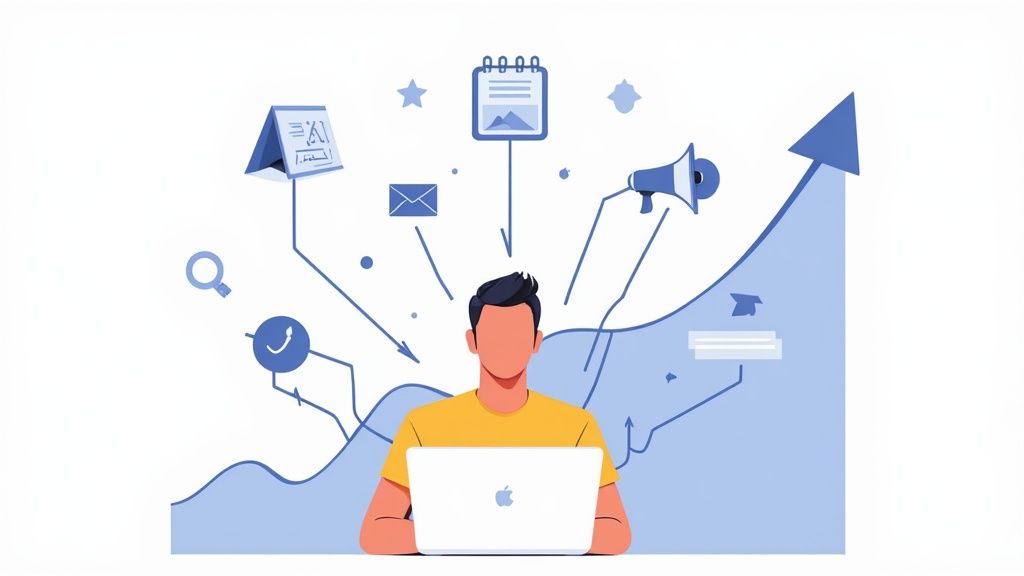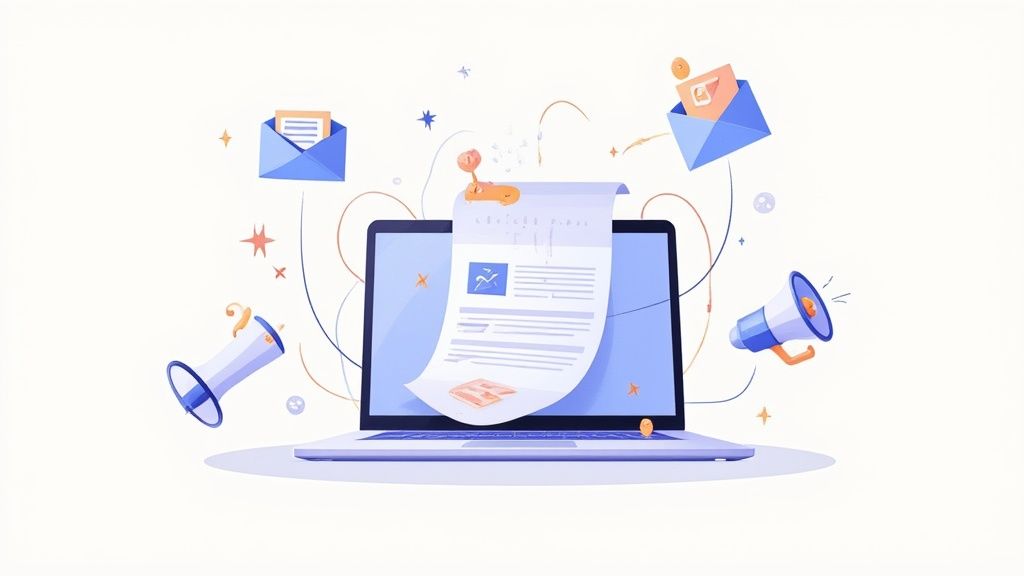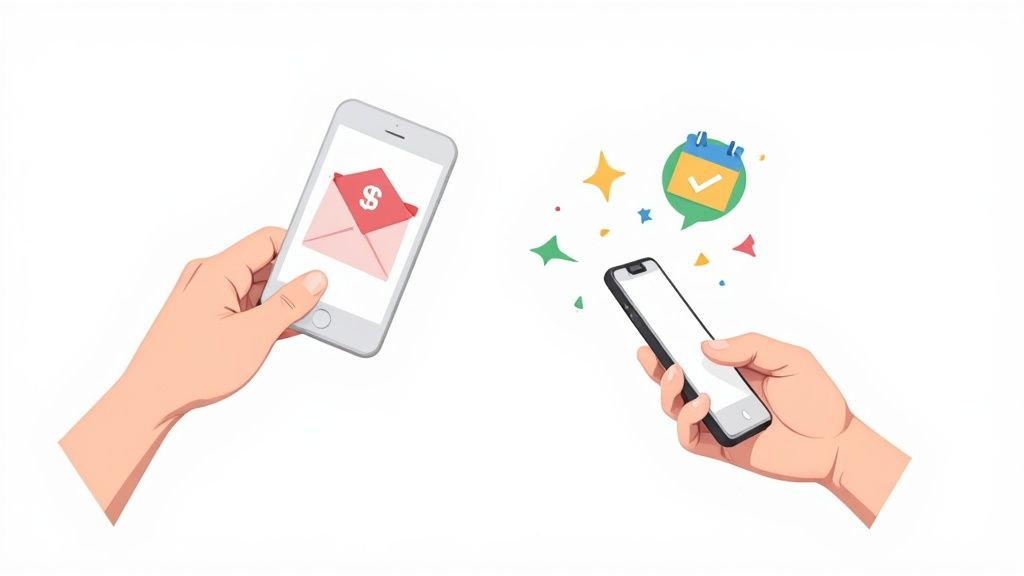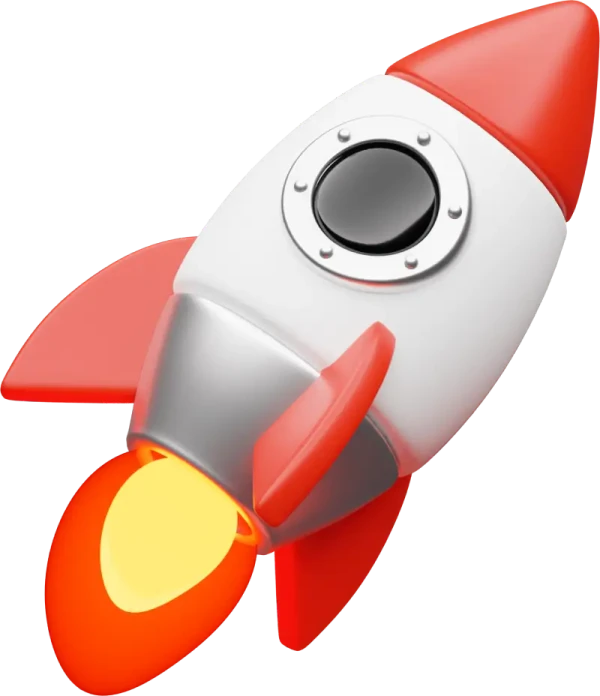Before you even dream of sending that first email or crafting the perfect social media post, your event's success hinges on something far more fundamental: your game plan. Rushing this part is the single biggest mistake I see people make, and it's the difference between a sold-out success and a room full of echoes.
This isn't about a simple to-do list. It’s about building a solid foundation that informs every single promotional move you make.
Laying the Groundwork for a Winning Event
The first, non-negotiable step? Knowing exactly who you're talking to. Don't just settle for basic demographics like age and city. You need to go deeper.
What are their biggest professional frustrations? Where do they hang out online? What podcasts are in their earbuds during their commute? Nailing down a detailed attendee persona is like getting a cheat code - it allows you to craft messages that resonate and pick promotional channels where they actually live.
Figure Out Your "Why" and Your "What's In It For Them"
With a clear picture of your audience, you can set goals that truly matter. Sure, ticket sales are the obvious one, but think bigger. Are you trying to generate a list of hot leads for your sales team? Maybe you're looking to establish your brand's authority in a new market, or simply build a thriving community.
Whatever your goals are, make them SMART:
- Specific: "Sell 500 tickets" crushes "sell more tickets."
- Measurable: Track everything - ticket revenue, website traffic, social shares, you name it.
- Achievable: Be ambitious, but ground your targets in reality. Look at past events or industry benchmarks.
- Relevant: Your event goals must line up with your bigger business objectives.
- Time-bound: A deadline creates urgency. "Generate 100 leads by May 1st" is a clear target.
Next up is your value proposition. This is your event's heart and soul, boiled down to a single, powerful promise. It answers the most critical question every potential attendee has: "Why should I spend my time and money on this specific event?"
It’s not about what your event is, but what it does for the person attending. Does it teach a must-have skill? Does it offer exclusive access to industry titans? Does it solve a nagging problem that's been keeping them up at night?
Your value proposition is the hook. It's the core message that will drive all your ad copy, your email subject lines, and your social media posts. Get this right, and everything else gets easier.
Build Your Promotional Hub
Once your strategy is locked in, it’s time to build your core assets. The most critical piece of this puzzle is a dedicated event landing page. Think of this as the central station for everything related to your event. It's where all roads lead.
This isn't just an info dump; it's a conversion machine designed to turn curious visitors into registered attendees. If you're looking for some inspiration, checking out excellent event landing page examples is a great way to see how the pros present information and drive action.
This foundational work - knowing your audience, setting clear goals, and building your core assets - is what transforms random acts of marketing into a focused, predictable engine for selling out your event.
Building a Buzz on Social Media
Let's be real: just posting "Hey, we have an event!" on social media isn't going to sell tickets. If you want to turn your passive followers into genuinely excited attendees, you need a plan. This is about more than just broadcasting - it's about building a community and creating momentum that pulls people in.
First things first: stop trying to be everywhere at once. Focus your energy where your ideal attendees actually hang out. If you're hosting a B2B tech summit, your prime real estate is LinkedIn. Got a vibrant food festival on the calendar? The visual storytelling on Instagram is your best friend. Planning a community-focused workshop? A dedicated Facebook Group is where you'll get the most traction.
Map Out a Content Plan That Builds Hype
Once you've zeroed in on your platforms, it's time to build a content calendar that tells a story. Think of your promotion as a slow burn, starting with a whisper and building to a roar as event day gets closer.
You need a mix of content to keep things interesting. Here's a quick rundown of what I've seen work time and time again:
- Early-Bird Specials: Kick things off with a sense of urgency. Don't just frame it as a discount; position it as an exclusive reward for your most dedicated followers.
- Behind-the-Scenes Glimpses: Make the event feel real and human. Share snaps of the team doing a venue walkthrough, unboxing the swag, or in the middle of a chaotic planning session. It pulls back the curtain.
- Speaker Spotlights: A headshot and a bio are table stakes. Go deeper. Post short video clips of your speakers talking about why they're excited to present. A powerful quote can do more to build credibility than a whole paragraph of credentials.
- Interactive Content: Get your audience involved. Run polls asking what sessions they're most jazzed about or what food truck they hope to see. This isn't just for engagement - it's free market research.
This infographic really drives home how different channels work together to create that buzz.
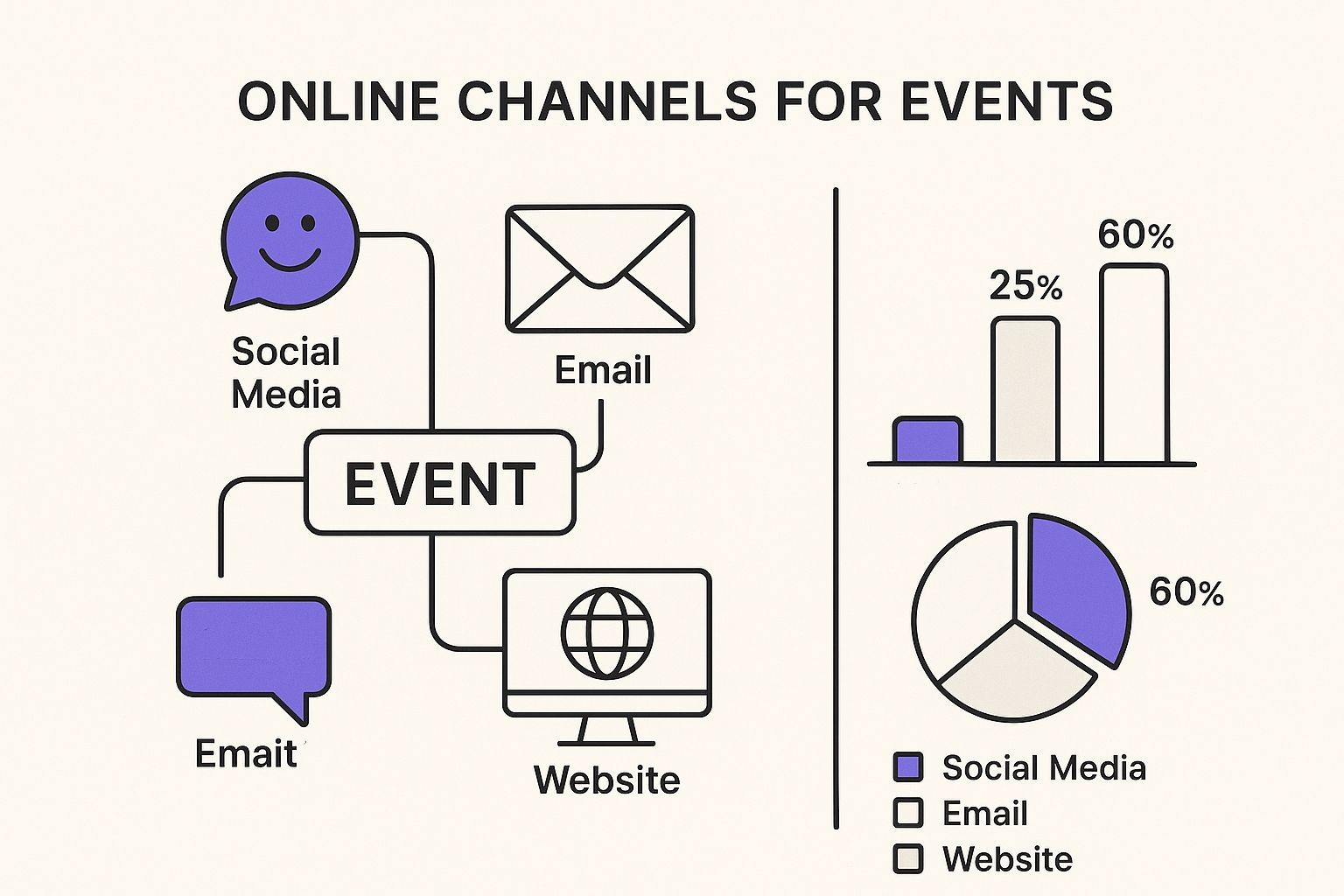
The takeaway is crystal clear: a strategy that blends your website with a strong social media presence is the most reliable way to connect with your audience.
Drive Real Engagement with Proven Tactics
The data doesn't lie - social media is where the action is. An incredible 83% of event marketers lean on social media for promotion. The big players? Facebook (86%), Instagram (79%), and LinkedIn (65%). And with 66% of marketers incorporating video, it's obvious that static posts just don't capture attention like they used to. If you want to geek out on more numbers, check out these event industry statistics from remo.co.
The core idea here is to shift your mindset. You're not just broadcasting information; you're starting a conversation. The goal is to make people feel like they're part of the event long before they walk through the door.
To really get things moving, think about a user-generated content (UGC) campaign. It’s one of the most powerful tools in your kit.
Ask your followers to share a favorite memory from a past event or post about why they're pumped for this year's, all using a unique event hashtag like #YourEvent2025. Sweeten the deal by offering a prize for the best post - maybe a free ticket or a VIP upgrade.
This creates authentic social proof that no paid ad can ever match. It builds a genuine sense of community and makes attendees feel like they have a personal stake in the event's success.
Platform-Specific Social Media Promotion Tactics
Choosing the right platform is only half the battle. You have to speak the language of each one to truly connect with the audience there. Below is a quick breakdown of how to tailor your approach for maximum impact.
| Platform | Primary Audience | Top Promotion Tactic | Key Metric to Track |
|---|---|---|---|
| Gen Z & Millennials, B2C, Visual Brands | Reels showing behind-the-scenes content; Countdown stickers in Stories. | Story Views & Sticker Taps | |
| Gen X & Millennials, Community-focused | Create a dedicated Facebook Event page; Run targeted ads to lookalike audiences. | Event Responses (Going/Interested) | |
| Professionals, B2B, Corporate | Speaker spotlights with their professional background; Post articles about event topics. | Post Engagement Rate | |
| X (Twitter) | News Junkies, Tech, Media | Live-tweeting Q&As with speakers; Running polls about session topics. | Hashtag Mentions & Reach |
By pairing a solid content calendar with these kinds of interactive, platform-specific tactics, you'll generate real excitement that you can see in your ticket sales.
Converting Interest with Email and Content
Social media is fantastic for building hype, but your owned channels - especially your email list - are where you turn that excitement into actual registrations. This is your direct line to people who’ve already shown interest, and it’s time to start a conversation that feels personal and genuinely valuable.
The big secret to staying out of the spam folder? Smart segmentation. Never blast the same message to your entire list. Think about it: someone who attended your last event already knows and trusts your brand. A simple "welcome back" offer might be all they need. On the other hand, a new lead from a webinar needs a bit more convincing about what makes your event a can't-miss experience. This tailored approach is what makes all the difference.
Crafting Emails That Get Opened
Your subject line is the gatekeeper. Make it count. Ditch the generic "Event Update" and try something that sparks a little curiosity or offers obvious value right away.
- For urgency: "Last Chance: Early Bird Pricing for Event Name Ends Friday"
- For curiosity: "A sneak peek inside the Event Name agenda..."
- For personalization: "John, are you ready for Main Benefit of Event?"
A good email sequence guides your subscribers on a journey. You can start with a simple "Save the Date," then build excitement by revealing speakers or sessions, and finally, ramp up the urgency with those "last chance" reminders as the event gets closer. If you're looking for more ideas on this, our complete guide on email marketing for events dives much deeper into creating campaigns that really work.
Beyond Email: Nurturing with Content
Your promotion shouldn't be confined to the inbox. High-quality content is a secret weapon for attracting the right attendees organically and proving your event is the real deal. Move beyond basic announcements and start creating resources that actually solve problems for your target audience.
For example, why not publish a blog post with an in-depth interview with your keynote speaker? Or a detailed case study from a company that saw huge benefits from last year's event? This stuff isn't just filler; it provides real value and gives your event's SEO a massive boost, helping people find you through a simple search.
The goal is to position your event not just as a one-time thing, but as the epicenter of valuable industry knowledge. This content proves you understand your audience's challenges and have the solutions.
This direct, personalized approach flat-out works. With an average open rate of 32.55%, email is still a top-tier channel for engaging directly with your audience. The power of making it personal is undeniable - 64% of consumers say they are more likely to buy when experiences are tailored to them. What's more, 89% of marketing decision-makers see it as essential for future success. You can see more data behind these event industry trends on remo.co. When you combine targeted email with truly valuable content, you create a powerful one-two punch that drives registrations like nothing else.
Expanding Your Reach with Ads and Partners
Organic social media and your email list are fantastic for nurturing the community you already have. But what about everyone else? To really grow your event, you need to reach people who have never heard of you.
This is where you bring in the heavy hitters: a smart mix of paid advertising and strategic partnerships. It’s how you turn a conversation with your existing audience into a broadcast to the world.
Laser-Focused Paid Advertising
Paid ads aren't about shouting into the void; they're about precision surgery. Platforms like Facebook, Instagram, and especially LinkedIn (for any B2B or professional event) let you target potential attendees with mind-boggling detail. You can go way beyond basic demographics and get in front of people based on their job titles, industry, or interests they've shown in topics directly related to your event.
Let's say you're hosting a conference for software developers. With LinkedIn Ads, you could serve your promotion directly to people with titles like "Senior Software Engineer" or "Engineering Manager." It’s that specific. On Facebook, you might target users who follow influential tech blogs or have shown interest in coding bootcamps.
You don’t need a massive budget to get started, either. The real magic isn't in how much you spend, but in your ad creative and targeting.
- Design for Conversions: Your ad's image or video has to be a scroll-stopper. Make sure the event name, date, and core value prop are front and center. I've often found that a short video highlighting moments from a past event can easily outperform a static image.
- Embrace Retargeting: This is absolutely non-negotiable. By placing a pixel on your event landing page, you can serve follow-up ads to people who visited but didn't sign up. These are warm leads, and they are far more likely to convert when you give them a gentle nudge.
Retargeting is your second chance to make a first impression. A simple ad that says, "Still thinking about Event Name? Early bird pricing ends soon!" can be incredibly effective at pulling people back over the line.
The Power of Partnerships
Paid ads work, but partnerships offer something just as valuable: borrowed trust. When you collaborate with the right people and brands, you're placing your event in front of a new, relevant audience that already trusts the source. It’s a powerful shortcut.
Consider a few different types of collaborations:
- Industry Influencers: Find a respected voice in your field. They don't need a million followers - a micro-influencer with a smaller, but highly engaged, niche audience can be pure gold.
- Media Outlets: Offer an exclusive interview or a sneak peek to an industry blog, podcast, or online publication. In return, you get a promotional feature that looks like editorial, not an ad.
- Complementary Brands: Team up with a non-competing business that serves the same audience you do. A simple cross-promotion to each other’s email lists or social channels can work wonders.
These strategies expand your reach far beyond what you could achieve alone. For a deeper dive into more creative ways to get the word out, we've gathered a list of powerful event promotion ideas you can use right away.
By combining hyper-targeted ads with authentic partnerships, you create a powerful engine for ticket sales that will help you fill every seat.
Getting Smart with Your Promo Tech
Look, the best event marketers out there aren't just grinding harder - they're working smarter. The real secret is leaning on the right technology to handle the boring stuff, pull in data you can actually use, and personalize your promotions without having to clone yourself. This is where you find your competitive edge.
The core of any modern event promotion strategy is a solid Event Management System (EMS). Think of it as the mission control for your entire campaign. It's so much more than just a ticket-selling tool; it's the single place where you manage registrations, handle payments, and - crucially - see all your analytics from every channel you're using.
The Rise of AI in Event Marketing
Once you've got your EMS sorted, the next big leap is bringing Artificial Intelligence (AI) into the mix. It's quickly changing how we all approach marketing by adding a layer of genuine intelligence to our campaigns. The goal isn't just about being faster; it's about making your promotion radically more effective.
With AI, you can start to:
- Personalize on a massive scale: Analyze attendee data to fire off emails or ad copy that feels like it was written just for them.
- Stop wasting ad money: Automatically shift your campaign budgets to the channels that are actually bringing in registrations and delivering the best ROI.
- See the future (sort of): Use your past event data to forecast ticket sales, which is a lifesaver for planning resources.
This isn't some far-off, futuristic concept anymore. It's a practical tool that's here now. There’s a good reason its adoption is skyrocketing - 79% of professionals already rely on EMS tools, and a full 50% plan to bring in AI to level up their marketing and operations. If you want to dig deeper into how the industry is shifting, you can check out some powerful event industry statistics over on eventgroove.com.
The real magic of this tech stack is the data. Your EMS gives you the raw numbers, but it’s AI that helps you figure out what those numbers actually mean and what you should do next. It turns your promotion from a guessing game into a data-backed strategy.
Practical Applications That Actually Drive Results
Let me paint a picture for you. Imagine you glance at your EMS dashboard and see that your LinkedIn ads are bringing in high-value registrations, but your Facebook ads are completely bombing. Instead of you having to manually go in and tweak the budgets, an AI-powered ad tool can do it for you instantly, making sure every single dollar is working its hardest.
Here's another one. An AI tool could comb through your past attendee data and tell you that a "last chance" email sent on a Tuesday morning gets 15% more opens than the same email sent on a Friday. These might seem like small tweaks, but these data-driven optimizations add up fast, saving you a ton of time and giving you the tangible results you need to prove your promotional success to your boss or stakeholders.
Promoting Virtual and Hybrid Events
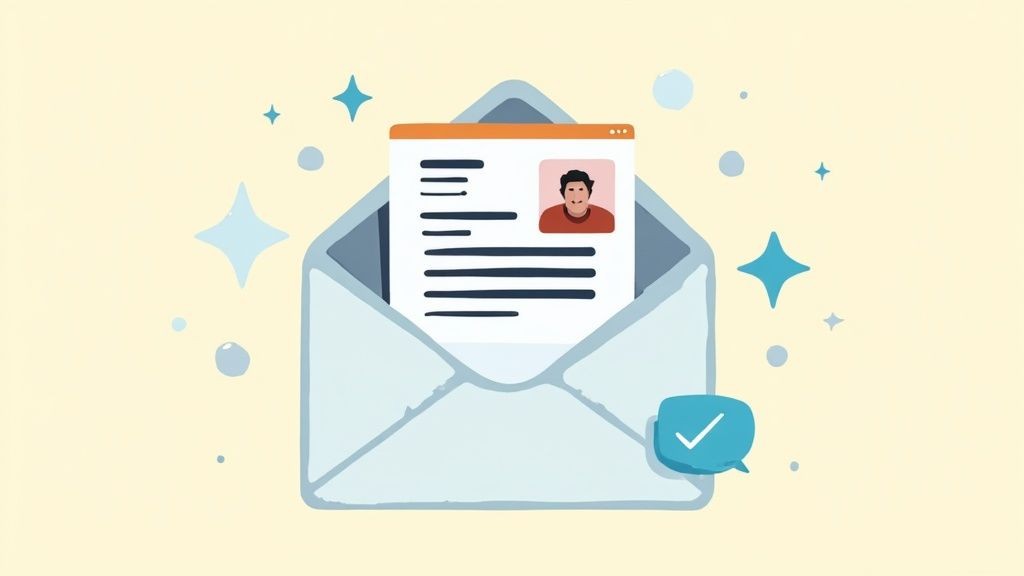
Marketing a virtual or hybrid event is a whole different ballgame. You're not just selling a ticket to a place; you're selling an experience delivered through a screen. That means your promotion needs to be crystal clear about the unique value of showing up digitally.
Forget hyping up the venue. Instead, your talking points should be all about the real perks: global access for anyone, anywhere; on-demand content they can re-watch later; and innovative virtual networking lounges that actually foster connections. For a remote audience, these are seriously powerful draws.
Bridge the Digital Divide
To get your remote audience buzzing before the event even kicks off, you have to get creative with digital-first tactics.
I've seen a lot of success with "digital swag bags." Think about sending a package of goodies like exclusive discount codes, pre-release content, or vouchers for online courses. Another great move is offering early access to a private Slack or Discord community. It's a fantastic way to build connections and ramp up the excitement.
The real trick with hybrid events is crafting a single, unified message that clicks with both your in-person and virtual crowds. Your marketing has to convince everyone that they're getting a premium, complete experience that’s been thoughtfully designed for them, no matter how they attend.
A word of advice: Never let your virtual ticket feel like a consolation prize. You have to position it as its own distinct, feature-rich way to participate. The goal is to make sure nobody feels like they're getting a watered-down version of the main event.
Confidence in these new formats is sky-high, and for good reason. By 2025, a staggering 95.5% of event professionals plan to keep virtual events as a core part of their strategy. On top of that, 90% of marketers are happy with how they've performed. Even with some bumps in the road, 61% still see events as their most critical marketing tool. You can dig into more stats on the rise of hybrid events from Bizplanr.ai.
At the end of the day, successfully promoting events online - especially in these modern formats - is all about showing people you've put in the work to design an amazing experience for every single attendee.
Got Questions About Event Promotion? We’ve Got Answers.
Even with the best-laid plans, you're bound to hit a few snags when you're deep in the trenches of event promotion. Getting quick, reliable answers can be the difference between losing steam and crushing your goals.
Let's walk through some of the most common questions we hear from marketers and get you some practical advice.
When Should I Start Promoting My Event?
This is the big one, and the honest answer is: it depends entirely on the size of your event.
If you’re planning a massive conference or a sprawling trade show, you need to be thinking 3-4 months out, minimum. That gives you a long runway for a multi-stage campaign. For smaller, more intimate events like a webinar or a local workshop, a tighter 6-8 week timeline usually hits the sweet spot.
Your first move should be a simple "save the date" announcement. Just get on people's radar. After that, you can start layering in more compelling content - think early-bird ticket sales, speaker reveals, and sneak peeks of the agenda.
The real goal isn't just to make a single, loud announcement. It's to build a steady drumbeat of excitement that gets louder as the date gets closer, keeping your audience hooked the whole time.
How Can I Promote an Event with No Budget?
A tiny budget isn't a dead end; it's a creativity test. You just have to pivot to activities that cost you time and brainpower, not cash.
- Go hard on organic social media. This means creating stuff people actually want to share. Behind-the-scenes video clips, eye-catching quote graphics from your speakers, or interactive polls are all great places to start.
- Lean on your email list. That list is pure gold. These are people who already know and trust you, so treat them to exclusive updates and inside info.
- Tap into community calendars. Hunt down free online event listings, industry forums, and relevant community groups on platforms like Facebook or LinkedIn and submit your event details.
- Launch a simple referral program. Give attendees a small discount on their ticket for every friend they get to sign up. It’s a classic for a reason.
What Are the Most Important Metrics to Track?
Ticket sales are the finish line, but they don't tell you the whole story of the race. To really understand what’s working, you need to look at the metrics that feed into that final number.
Pay close attention to website traffic from each of your promotional channels. Where are people coming from? Also, keep a close eye on your email open and click-through rates and, of course, social media engagement.
Your registration page's conversion rate is absolutely critical. It tells you exactly how effective your page is at turning casual visitors into registered attendees. And if you're putting money into paid ads, you have to be tracking your cost per acquisition (CPA).
Make sure every attendee knows exactly when and where they need to be. With Add to Calendar PRO, you can drop simple, reliable "Add to Calendar" buttons right onto your website, landing pages, and emails. Our platform handles all the tricky stuff - from time zones to RSVPs - so your audience gets a perfectly smooth experience. Get started for free and see for yourself.
